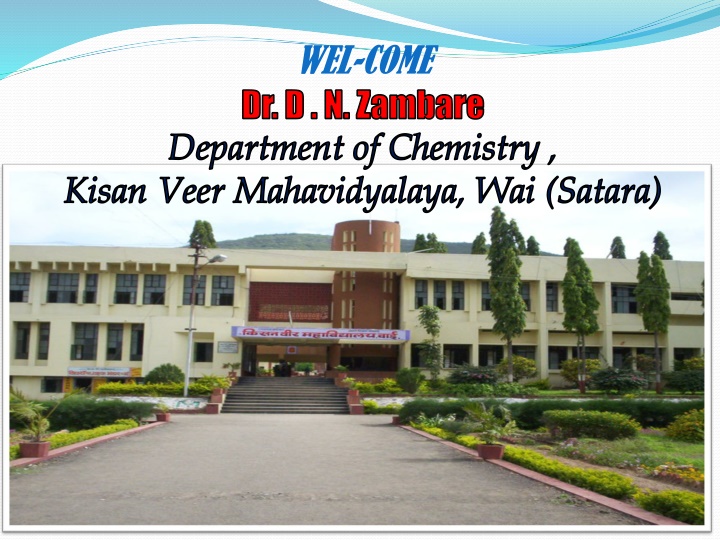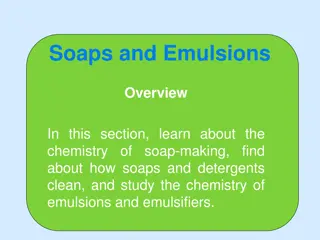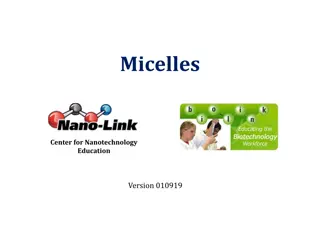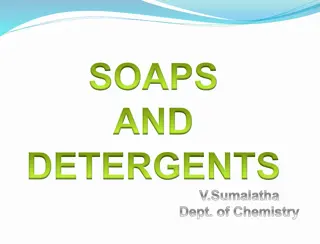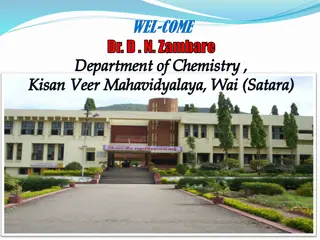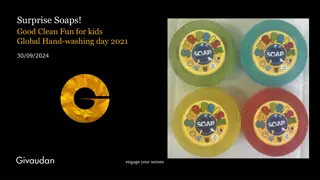Chemistry of Soaps and Detergents Evolution and Formation
Soaps and detergents play a vital role in human comfort, cleanliness, and industrial applications. This article delves into the chemistry involved in the formation of soaps, highlighting the compounds and processes. It explores the differences between soaps and detergents, detailing their origins and development over the years. The content covers the introduction of soap, its production methods, and the comparison between soaps and synthetic detergents. Additionally, it discusses the role of fatty acids and esters in soap formation, shedding light on the saturated and unsaturated varieties commonly found in oils and fats.
Download Presentation

Please find below an Image/Link to download the presentation.
The content on the website is provided AS IS for your information and personal use only. It may not be sold, licensed, or shared on other websites without obtaining consent from the author.If you encounter any issues during the download, it is possible that the publisher has removed the file from their server.
You are allowed to download the files provided on this website for personal or commercial use, subject to the condition that they are used lawfully. All files are the property of their respective owners.
The content on the website is provided AS IS for your information and personal use only. It may not be sold, licensed, or shared on other websites without obtaining consent from the author.
E N D
Presentation Transcript
WEL-COME Dr. D . N. Zambare Department of Chemistry , Kisan Veer Mahavidyalaya, Wai (Satara)
4.Soaps and Detergents 4.1 Introduction 4.2 Soaps i. Raw materials, ii. Types of soaps iii. Cleaning action of soap 4.3 Manufacture of soap i. Cold Process ii. Semi-boiled Process iii. Boiled or Hot Process 4.3 Detergents i. Raw Materials ii. Types of Detergents: Anionic, cationic and amphoteric 4.4 Comparisons between soaps and detergents.
4.1 Introduction of Soap Soaps and detergents are used for human comfort, cleanliness and for industrial purposes. A detergent is a cleansing agent. Hence soap is also a detergent in the proper sense of the term but it is differentiated from the other type of cleansing compounds known as synthetic detergents on the basis of the difference in their structures. Soap itself was never discovered but instead gradually evolved from crude mixtures of alkaline and fatty materials. Soap has been known for the last 2000 years. Detergents have been of recent origin. Synthetic detergents now occupy a vital place in modem chemical science. This industry has made a rapid progress after the Second World War. Its development is very much linked with the growth of petro- chemical industry which provides basic raw materials for it. As soap is manufactured from oils and fats derived from vegetable and animal sources, if we turn our attention to manufacturing of detergents from petro-chemicals we can save the oils and fats which are used as foods. Detergents are sometimes called as soap less soaps.
i) Chemistry Involved in Soap Formation: Soaps are compounds of general formula RCOO-M+, where R.C00- is a higher fatty acid residue while M+ is an alkaline residue. Ordinary soap is obtained by the action of alkali on fats, oils or free fatty acids. Animal as well as vegetable oils and fats are mixtures of esters known as glycerides. As we know an ester is made up of two parts; one part is that of an acid while the other part is that of an alcohol. In glycerides the alcohol part is the same in all cases. It is of glycerol (CH2OH.CHOH.CH2OH). The acid part is made up of a higher fatty acid, saturated or unsaturated. Hence glycerides may be defined as glycerol esters of higher saturated or unsaturated fatty acids. The following saturated and unsaturated fatty acids are commonly present in oils and fats in the form of their esters.
Saturated and unsaturated fatty acids are commonly present in oils and fats in the form of their esters Saturated Fatty Acids: 1. Lauric acid - C11H23COOH or CH3 (CH2)10COOH 2. Myristic acid- C13H27COOH or CH3(CH2)12COOH 3. Palmitic acid- Cl5H31COOH or CH3 (CH2)14COOH 4. Stearic acid - C17H35COOH or CH3(CH2)16COOH Unsaturated Fatty Acids: 1. Oleic acid C17H33COOH or (CH3 (CH2)7CH = CH(CH2)7 COOH ) 2. Linoleic acid CI7H31COOH or (CH3(CH2)3(CH2CH=CH)2 (CH2)7 COOH) 3. Linolenic acidC17H29COOH or (CH3(CH2)3(CH2CH = CH)3 (CH2)7 COOH)
CH2OOC C17H35 | CHOOC C17H35 + | CH2OOC C17H35 Actually, we will be getting a mixture of sodium salts of different fatty acids. This mixture is known as soap. In recent years, the tendency has been to hydrolyse the fat or oil first with water and after recovery of glycerol neutralise the fatty acid mixture obtained with alkali to get soap. C3H5(OOC C17H35)3 + 3H2O , C3H5(OH)3 + 3C17H35COOH glycerol Stearic acid C17H35COOH + NaOH C17H35COONa + H2O Stearic Caustic Sodium stearate acid soda (soap) NaOH CH2OH | | NaOH | | NaOH CH2OH (Glycerol) Sodium stearate (Soap) CHOH + 3 C17H35COONa
i. Raw materials: 1. Alkaline Materials: a) Sodium carbonate (Na2CO3): This is a non-saponifying alkali and hence is used to prepare soaps from fatty acids but not from oils and fats. b) Caustic soda (NaOH): This is the most widely used alkali in the manufacture of hard soaps which are most common. As this is a saponifying alkali it can be used for oils, fats and fatty acids as well. c) Caustic potash (KOH): This is used for getting soft-soaps from fats and fatty acids. d) Ammonium hydroxide (NH4OH): Its use is similar to that of carbonate. e) Ethanolamines: These can be considered as derivatives of ammonia in which one or more hydrogen atoms are replaced by CH2.CH2OH group. NH2CH2.CH2OH NH. (CH2.CH2OH) 2 N (CH2.CH2OH) 3 Mono-ethanolamine diethanolamine triethanolamine
2. Common Salt (NaCl): This is required for salting out process during the manufacture of soaps. It should be free from impurities like Fe, Cu, and Mg. 3. Fats, Oils and Fatty Acids: a) Tallow: This is the principal fatty material used in the soap making. It is derived from the fat of cow, oxen, sheep, goat and other animals. It consists essentially of two glycerides: olein (40%) and stearin (60%). This is usually mixed with coconut oil to reduce the hardness and increase the solubility of the soap. b) Grease or lard: This is the second important raw material for soap making. It is obtained from pigs. It is a soft fat like butter and consists mainly of olein (60%) and stearin (40%). It is used in making best grade of soaps.
Raw material c) Coconut oil: This ranks third in soap manufacture. The principal fatty acid present in it is Lauric acid C11H23COOH. The oil is fairly easily saponified and hence employed in soap making by cold process. It gives a hard white soap having good lathering properties. d) Palm oil: It is one of the widely used oil. It consists chiefly of palmitin and olein. It has very good cleansing action. e) Linseed oil: This is easily saponified by boiling with caustic alkalies and nearly all soft soaps are made from it. It contains linoleic acid C17H31COOH to a large extent. f) Castor oil: This is obtained from seeds of castor oil plant. It contains chiefly an unsaturated hydroxy acid known as ricinoleic acid C17H32(OH)COOH. It is easily saponified and the soap obtained is transparent. Hence this is one of the raw materials employed in making transparent soaps.
g) Cotton seed oil: This oil is obtained from the seeds of the cotton plant. It contains olein, stearin and palmitin. The soap from this lathers freely. h) Groundnut oil: This contains larger proportions of unsaturated acids like oleic. It is first hydrogenated before manufacture. i) Maize oil: This is cheaper than groundnut oil and is replacing it in industry. j) Fatty acids: As said earlier these are obtained from oils and by hydrolysis employed for soap
4. Other Additives: a) Rosins: Rosin is a plant product obtained from pine trees. b) Builders: Compounds under this category build up i e. increase the detergent power of soaps. c) Anti-oxidants: Soap is susceptible to rancidity and therefore has to be protected from this defect. d) Fillers: These add to the weight of soap without in any way improving its detergent power. e) Colouring matters: These are synthetic chemicals added to give desired colours pleasing to the eye. f) Perfumes: A perfume is added to attract the customer g) Fixatives: These are used to retain for a longer time the perfumes added. Important fixatives are gum benzoin, tolubalsam, balsam etc. h) Optical brightners: These are the latest additives. These give an effect of increased whiteness. Phenyl benzo thiozole and benzo coumarin are two such brightners
ii. Types of soaps: (i) Household soaps: These comprise of various laundry soaps, soap chips and powder. Laundry Soap contains fillers and builders like sodium carbonate, silicate, clays and sodium sulphate. ii) Toilet soaps : These are very rich in sodium oleate. They are manufactured from the best quality fats and oils (iii) Medicated soaps: These are soaps containing medicinal ingredients like phenol, cresols, etc. These have germicidal and antiseptic properties. iv)Shaving soaps: These are potassium soaps and contain excess of stearic acid. The oils used in their preparation are coconut and palm kerne1 oils.
v) Industrial soaps: Textile soaps have a wide field in textile processing. A good quality textile soap must be fairly soluble in water. It must not deposit anything on fibre and should not be harmful to it. iii. Cleansing action of soap: The cleansing action of soaps is complicated. A simple explanation of the action is given below. A soap molecule always has a non-polar hydrocarbon end that is oil soluble (liophilic) but insoluble in water (hydrophobic). The soap molecule also has a polar end that is water soluble (hydrophilic). Thus in the case of soap sodium stearate, we have C17H35 COO-Na+ Nonpolar end Polar end (Water Insoluble) (Water soluble)
material to be cleaned. Ordinarily oil droplets when they come in contact with water tend to unite into one body so that there form two layers, one of oil and another of water. But in presence of an aqueous solution of soap, this picture changes. The non-polar ends of soap molecules dissolve in oil droplets and the carboxylate ends project into the surrounding water layer. The dirt is held by a thin film of oil or grease on the
4.2. Manufacture of Soap: i. Cold process: Coconut oil and tallow are most suitable for this process, since they saponify readily and can take up an appreciable quantity of fillers. In this process a cylindrical flat bottomed pan or a crutcher is used. The oil or a mixture of oils and fats is taken in this vessel and heated to 40 - 45 C whereby a homogeneous liquid is formed. Now a calculated amount of alkali solution is slowly added to this with continuous stirring. The reaction is exothermic and there is no need of further heating. The mass begins to thicken up. Fillers, colours and perfume are added at this stage and stirring continued. The hot thick mass is now poured into cooling frames before it becomes too viscous. This is allowed to remain for 24 hours to complete saponification and hardening. This is then cut into slabs, stamped and packed.
ii. Semiboiled process: Good quality laundry soaps and toilet soaps are manufactured by this or the next process known as full boiled process. The principle here is the same as the cold process, the only change being the temperatures. Saponification is carried out in a big sized pan which is set into a furnace. The temperature of the pan is kept at 80 C. The fatty matter is placed in the pan and the alkali solution (calculated amount) is gradually added to it. The heat keeps the mass boiling and good mixing takes place if necessary stirring by hand rod is done. On the complete addition of the alkali, the mass is allowed to boil slowly for two hours. Fillers, colour and perfume are added towards the end of the boiling. The hot mass is now poured into frames and allowed to cool. This is then cut into bars, stamped and packed. Here also glycerine is lost as it remains in the soap.
iii. Full boiled or hot process: (a) Boiling or Saponification: This operation is carried out in a giant iron pan known as kettle (Fig. 4.1). The oil or fat taken is heated in this kettle by steam. A calculated amount of alkali solution is added in thin stream to the mass kept boiling by steam. The steam also keeps the mass in good state of agitation all the time. Alkali is maintained in a slight excess. The fat gets saponified to the extent of 80% at this stage and a frothy mixture of soap and glycerine is obtained. (b) Salting out or graining: Common salt or brine is added now to precipitate soap and heating continued for some more time. Soap being insoluble in brine solution is thrown out and floats to the surface as granular mass. Hence this process of salting out is also known as graining. The lower aqueous layer containing glycerol, common salt and unused alkali (spentlye) is drawn from below. This is worked out to recover glycerol.
Fig. 4.3: Manufacture of soap (Hot process)
(c) Finishing: The upper layer of pure soap is then transferred to a mixing machine known as crutcher [which is provided with steam jacket]. Here it is shredded into small chips and the liquid mass mixed with fillers, colouring matters, perfumes etc 4) Modern continuous hydrolysis and soap formation process: In this process (Ittner's process) the fat and a fat splitting catalyst like ZnO are introduced at the bottom of the hydrolysis tower where high pressure water at 230 - 250 C is passed counter currently to the fats, the hydrolysis is rapid and complete. Glycerine in the form of aqueous solution (15-20%) is removed from the bottom of the tower
4.3 Detergents (syndets): A detergent is regarded as a chemical formulation which essentially consists of surface active agents or surfactants and subsidiary constituents such as fillers, boosters, builders, etc Detergents must contain alkaline "builders" to bind the dissolved metal ions and support emulsification. Sodium pyrophosphate or polyphosphate is preferred because of low cost and high cleansing effectiveness
i. Raw Materials: The raw materials required for manufacture of detergent are mainly linear alkyl benzene sulphonate (LAS) and fatty alcohol sulphate. The -olefins high carbon content C10-C18 are required to get monoalkyl and hydrogen sulphate. Higher fatty acids are also used as raw materials for the manufacture of amide sulphate detergents. Most of inorganic materials such as oleum, caustic soda, and various sodium phosphates and a large number of additives are used as a raw material for detergents.
ii. Types of Detergents solvents, they are divide into two types namely, ionic and non-ionic. The ionic detergents are further sub-divided on the basis of active portion of detergents as anionic, cationic and a amphoteric (neutral) detergent. (1). Ionic (surface-active agents): These are sub-divided into three classes, namely: (a) Anionic: The anionic surfactants comprise those substances in which the surface-active properties are resident in the anion. They may be exemplified by soap, which in solution yields a simple cation e. g., Na+, and a surface-active carboxylate anion (RC00-). In addition to such carboxylates, the class includes many different types of sulphonates and sulphates (sulphuric esters) and other types which are of less importance. Anionic detergents are best for water-absorbing fibres such as cotton, wool and silk. Depending on the solubility of detergent in water or non-polar
(b) Cationic: The cationic surfactants are those in which the surface-active properties are resident in the cation. They include amine salts, quaternary ammonium compounds, and various other nitrogenous and non- nitrogenous bases. In general, they are less important as detergents, than as wetting agents and germicides. Some compounds of this type are used as "softeners" for textiles and paper. They are more expensive. (c) Amphoteric: The surfactants within this group contain both basic and acidic functions in their structure and can behave as anionic or cationic according to whether the solution is in the basic or acidic pH range.
( A )Anionic Surfactants: These are mainly divided into two main groups: 1. Sulphates, and 2.Sulphonates. We shall discuss these one by one. 1. Sulphates: These are of the following types: (a) Aliphatic sulphates: A typical example of these is sulphated casteroil which is also known as Turkey red oil. It is manufactured by adding sulphuric acid to castor oil slowly with continuous stirring and maintaining the temperature at 25-30 C. The main chemical reaction in this sulphonation process involves the sulphonation of ricinoleic acid which is a hydroxy acid present in castor oil.
(b) Sodium alkyl sulphates: These are the half esters of an acid and manufactured from higher alcohols which in turn are produced from fats (viz. coconut oil, palm-kernel oil and tallow) and from sperm oil. (c) Amide sulphates: They are manufactured by condensing a fatty acid with an alkylolamine, followed by successively sulphonation and neutralisation of the product. As amide sulphates possess good foaming characteristics, they are good detergents (d) Sodium secondary alkyl sulphates (Teepol): On a large scale, a typical teepol is prepared by treating -olefins having a high carbon content of C10 - C18 with concentrated sulphuric acid at low temperature, with efficient agitation for a short duration. The olefins required for are obtained by the thermal cracking of slack wax.
2. Sulphonates These are of the following types: (a) Sodium alkyl sulphonates: When the sulphochlorination of a C14 - C16 paraffinic fraction of petroleum is carried out, sulphony1 chlorides are obtained. These on heating with sodium hydroxide solution yield sodium alkyl sulphonates. b) Amide sulphonates: An important member of these is Igepon T. It is prepared from ethylene oxide and oleyl chlorideIn the textile industry, Igepon T is used for the scouring of wool, dying assistant, wetting agent, etc.
(c) Sodium dioctylsulphosuccinate: It is manufactured by treating maleic anhydride with octyl alcohol, followed by treating the product with sodium bisulphite solution. In textile industry, it is used as a wetting agent. (d)Sodium alkyl-aryl sulphonates: These are the outstanding detergents which are most widely produced by treating benzene with propylene tetramer to yield alkylating benzene followed by their sulphonation and neutralisation with sodium hydroxide solution. (e)Sodium alkylnaphthalene sulphonates: Important examples of these are isopropylnaphthalene sulphonate and di-n butylnaphthalene sulphonate.
(B) Cationic Surfactants: These are having surface activity from positively charged long-chain portion of molecule, therefore, they are known as invert soaps. These surfactants may be either nitriles, amines, amide-linked amines or quaternary nitrogen bases. Cationic surfactants may be prepared by reacting alkyl halides with fatty amines or tertiary amines. (c) Ampholytic Surfactants: They are so named because they have both cationic and anionic groups. A typical example of these is the water soluble sodium salt of N-fatty-P-aminopropionic acid. It is prepared by the saponification of the N-fatty- -aminopropionic ester which is, in turn, prepared by reacting a fatty primary amine and methyl acrylate.
2. Non-ionic (Surface-active agents): These contain groupings which are hydrophilic although non-ionogenic. The best known examples of this class are made by reacting a hydrophobic hydroxy cation, e.g., a phenol or alcohol, with ethylene oxide or propylene oxide. Ethylene oxide adducts: These are prepared by reacting hydrophobe fraction (e.g. alkyl phenol, fatty acid, alkyl mercaptan, fatty amide and fatty amine) with ethylene oxide at elevated temperature in the presence of a trace of sodium hydroxide or sodium acetate.
2. Alkylolamides: These constitute another important class of important non-ionic detergents. These are produced by first condensing alkanolamines with fatty acids. 3. Sugar surfactants: These are sucrose fatty acid mono-esters. An important example of these is sucrose monostearate which is prepared by dissolving three moles of sucrose, one mole of methyl stearate and 0.1 mole of potassium carbonate (catalyst) in dimethyl formamide or dimethyl sulphoxide. Then the reaction mixture is agitated, heated at 90-95 C at 80-100 mm of mercury for 9-12 hours. The methyl stearate reactswith the sugar to form a sucrose monostearate, and methanol. The latter is stripped off.
4. Sorbitol compounds: Sorbitol may be esterified partially with fatty acids and then these inner-ester sorbitol anhyd rides may be further reacted with ethylene glycol to give sorbitol surfactants. These may also be prepared by reacting sorbitol with ethylene glycol followed by esterification to varying degrees with lipophilic fatty acids. 5. Fatty amine oxides: These are produced by the oxidation of a tertiary amine having at least one long-chain group, with hydrogen peroxide. These are good detergents. However, these are sticky substances and hence their use in powder detergents is limited
Detergent Builders and Additives The builders may fall into the following groups: 1. Sodium sulphate: It is one of the most important additives used to improve the surface activity of the detergent. Any detergent prepared by sulphonation or sulphation can carry with it greater or smaller amount of sodium sulphate. 2. Sodium silicate: It is generally used as filler (diluent). The presence of silicate is quite helpful in softening hard water by forming precipitates which do not deposit on the fibre but are readily washed away. 3. Phosphates: Di-, tri- and tetrasodiuma phosphates were at one time used but are not in much demand now. However, condensed phosphates like sodium tripolyphosphate (Na2P2O10) are more commonly used these days
4. Carbonates: The various carbonates used are soda ash (Na2CO3), sodium bicarbonate sesquicarbonate (Na2CO3 NaHCO3 2H2O) and potassium carbonate (K2CO3). 5. Other additives: (a) Sodium carboxy methyl cellulose (CMC): It is extensively used with the detergents as an antiredeposition agent because it has the ability to suspend and prevent redeposition of the soil on the washed garments (b) Optical brightners: These are now-a-days added to all washing powders. These are not bleachers but are dyestuffs which are absorbed by textile fibres from solution and are not removed on rinsing. NaHCO3, sodium
(c) They improve the whiteness appearance of the fibre by counter-acting the natural yellowing tendency. The ingredients used for this purpose may vary from the long used ultra-marine blue to modern dyes. (d) Hydrotropes: These are added to liquid detergents. Their function is to "drive" the detergents and builders into the solution, to effect a solubilising action. Consequently, the built liquids remain clear and overcome freeze-thaw or high- temperature turbidity or sedimentation Bluings:
(e) Enzymes: Certain enzymes are added to the detergents to reduce stains. Enzymes added are generally proteolytic and amylolytic enzymes. (f) Opacifying agents: Some liquid detergents are formulated as clear table liquids while others cannot be 'clarified' or it may be desired that a cream like liquid be prepared. In either case, it is possible to prepare shelf-stable creamy liquids by adding water stable compounds (g) Miscellaneous compounds: Besides the above mentioned compounds, many other inorganic substances like borax, sodium chloride, magnesium sulphate, certain insoluble inorganic fillers like silica, quartz, marble dust, kieselguhr, etc. are also used purely as an abrasive in some detergent soap
4.5 Comparisons between Soaps and Detergents therefore, its cleansing action is reduced. The sticky precipitate causes graying of fabrics. But detergent can be used in hard water; they do not give the precipitate in hard water. 2. Soap cannot be used in acidic solutions because it decomposes in acidic medium and precipitates free fatty acids, which get adhered to textile fabric during processing. So dyeing becomes uneven which leaves light spots on the finished fabrics. 3. In aqueous solution soap gets hydrolysed and becomes alkaline. Therefore, it cannot be used with alkali sensitive dyes. It also causes irritation to skin. 4. Soap is insoluble in organic solvent, so it cannot be used in dry cleaning. 5. The fats and oils used for manufacturing of soap are having high nutritional value. Hence, they are wasted. 1. As soap gives precipitates (calcium or magnesium)
The advantages of detergents are as follows: 1. These can be used in hard water, because they do not give precipitates or salts of Ca2+ or Mg2+ are soluble. So these are used in textile processing industries. 2. These can be used for washing delicate fibres like silk, wool, etc. 3. The detergent do not hydrolysed in aqueous as well as in organic solvents. 4. They can be used for dry cleaning purpose, these are soluble in organic solvents. 5. Raw materials needed for detergents are cheap.
6. They are more active than soap even in low concentration. 7. Detergents are excellent foaming agent and possess germicidal and bacterial properties. 8. Its cleansing action is appreciably reduced in hard waters. Further, soap gets wasted in hard water. 9. It is more active than soap in comparatively low concentration. Due to the above mentioned and many other advantages, synthetic detergents are extensively used now-a-days.
